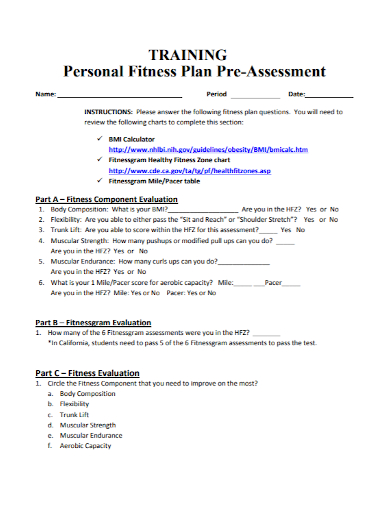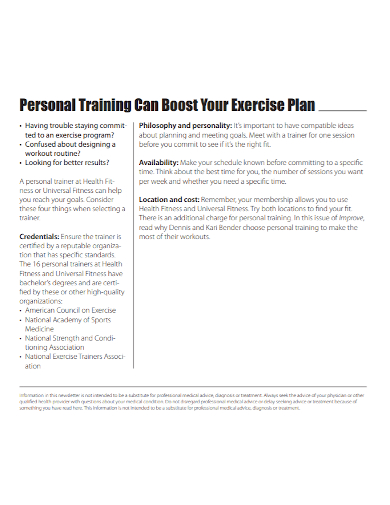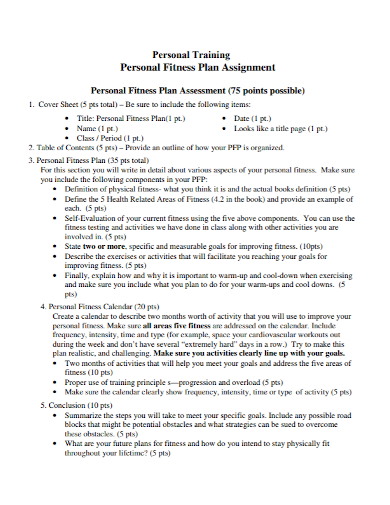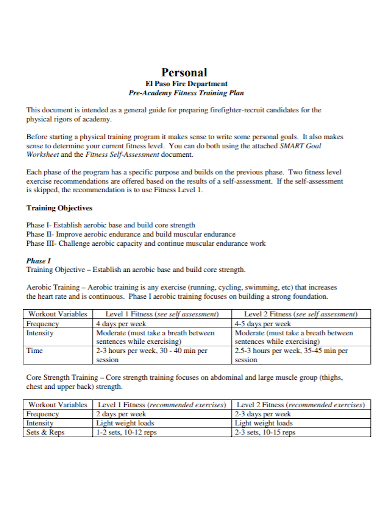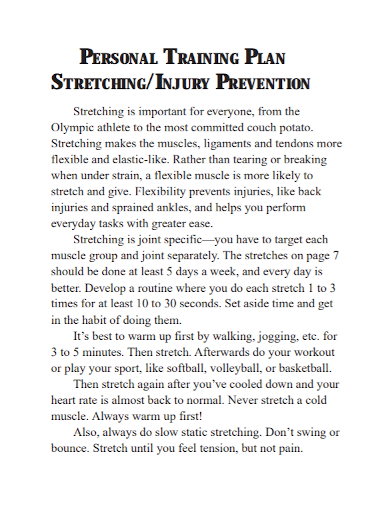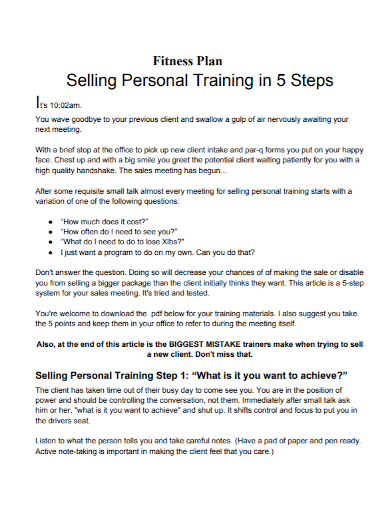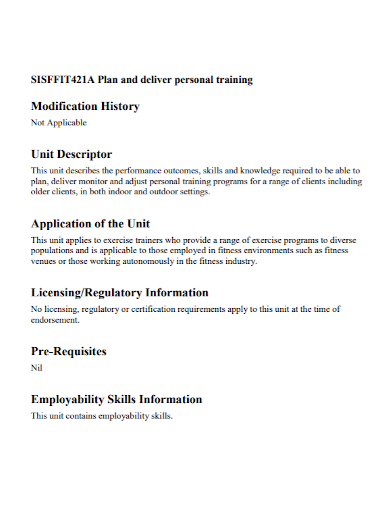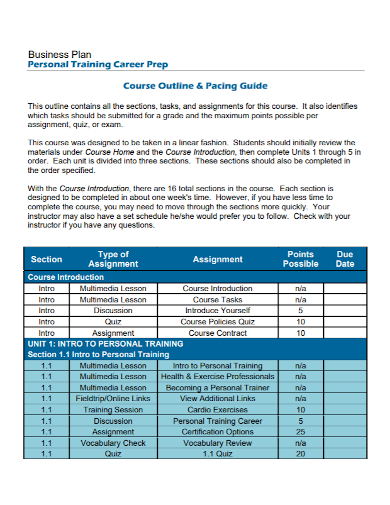Three-month workout programs are the most popular in the fitness world. Many of them have appeared in our magazine over the years. Are they successful? Absolutely. But we’ll let you in on a little secret: getting your feet wet in the gym doesn’t have to take eight or twelve weeks. Not that you’ll be a seasoned vet in four weeks, but if you can just get through that first month, you’ll have crossed the proverbial hump, where so many people fail and give up, and will have set the stage for a lifetime of muscle gains.
10+ Personal Training Plan Samples
According to Abraham and Collins, coaches value planning for a variety of reasons. Indeed, planning is important for a coach’s development because it encourages deep thinking, raises expectations for both the coach and the player, and provides a framework for thoughtful reflection after the delivery.
1. Personal Training Plan Template

2. Personal Consultation Training Plan
3. Personal Fitness Training Plan
4. Personal Training Exercise Plan
5. Personal Training Assignment Plan
6. Personal Academy Training Plan
7. Personal Training Monthly Plan
8. Personal Injury Training Plan
9. Selling Personal Training Plan
10. Personal Delivery Training Plan
11. Personal Training Career Plan
Training Plan Per Week
Week 1: You’ll start with a full-body training split, which means you’ll train all major body parts in each workout (rather than “splitting up” your workouts). This first week, train three days a week, doing only one exercise per body part in each session. To allow your body to recover, it’s important to take a day off between each workout; this makes training Monday, Wednesday, and Friday—with Saturday and Sunday as rest days—a good approach.
Week 2: Several exercises from Week 1 are carried over to Week 2, but one new move is added to each body part routine so you can train all muscle groups from different angles. For example, there are two exercises for the chest: one is a compound movement (dumbbell bench press) that works multiple joints (both the shoulder and elbow) to work the most amount of muscle possible, and the other is an isolation exercise (dumbbell flye) that works only one joint (shoulder) and primarily targets the pecs.
Week 3: Each body part routine has one new exercise added to provide even more angles from which to train your target muscles for complete development. You’ll do two exercises of 3–4 sets each for each muscle group: four sets for large body parts (chest, back, shoulders, quads, hamstrings) and three sets for smaller body parts (chest, back, shoulders, quads, hamstrings) (biceps, triceps, abs, calves). The result is 16 total sets for large body parts and 12 total sets for smaller body parts for the week—again, working in the 8–15 rep range—a significant increase in volume from Week 1.
Week 4: You’ll train four days in a four-way split that hits each body part only once in the fourth and final week of the program (except for calves and abs, which are each trained twice). Four-day splits are popular among experienced lifters because they involve training fewer bodyparts (typically 2–3) per workout, allowing you to devote more time to each muscle group while also increasing your volume. As you can see, the chest and triceps, as well as the back and biceps, and the quads and hamstrings, are all popular combinations among novice and advanced bodybuilders. Shoulders are mostly worked on their own, and every other workout you’ll alternate hitting calves and abs, which respond well to being worked multiple times per week. In Week 4, no new exercises are introduced so that you can concentrate on intensity rather than learning new movements during your workouts.
FAQs
Why is it important to assess your fitness level?
You probably have a good idea of your fitness level. Assessing and recording baseline fitness scores, on the other hand, can provide you with benchmarks against which you can track your progress.
How do you monitor your progress?
Six weeks after you begin your program, retake your personal fitness assessment, and then every few months after that. You may find that in order to continue improving, you need to increase the amount of time you exercise. Alternatively, you might be pleasantly surprised to discover that you’re exercising just enough to meet your fitness goals. Set new goals or try a new activity if you lose motivation. Exercising with a friend or enrolling in a fitness center class may also be beneficial.
Choosing to begin an exercise program is a significant decision. However, it does not have to be onerous. You can establish a healthy habit that will last a lifetime by carefully planning and pacing yourself.
Related Posts
FREE 7+ Fashion Business Plan Samples in PDF
FREE 10+ Sprint Planning Samples In MS Word | Google Docs | PDF
FREE 10+ Wedding Planning Samples in MS Word | Apple Pages | Powerpoint | PDF
FREE 9+ Monthly Study Planner Samples in PSD | Illustrator | InDesign | PDF
FREE 9+ Sample Curriculum Planning Templates in PDF | MS Word
FREE 10+ Teacher Development Plan Samples in MS Word | Google Docs | Apple Pages | PDF
FREE 10+ Basketball Practice Plan Samples in PDF
FREE 12+ School Business Plan Samples in PDF | MS Word | Apple Pages | Google Docs
FREE 7+ Client Strategic Plan Samples in PDF | MS Word
FREE 11+ Trucking Business Plan Templates in PDF | MS Word | Google Docs | Pages
FREE 7+ Small Hotel Business Plan Samples PDF | MS Word | Apple Pages | Google Docs
FREE 14+ Bakery Business Plans in MS Word | PDF | Google Docs | Pages
FREE 4+ Yearly Lesson Plan Samples in PDF
FREE 50+ Strategic Planning Samples in Google Docs | Pages | PDF | MS Word
FREE 10+ Construction Project Plan Samples in MS Word | Google Docs | Apple Pages | PDF


